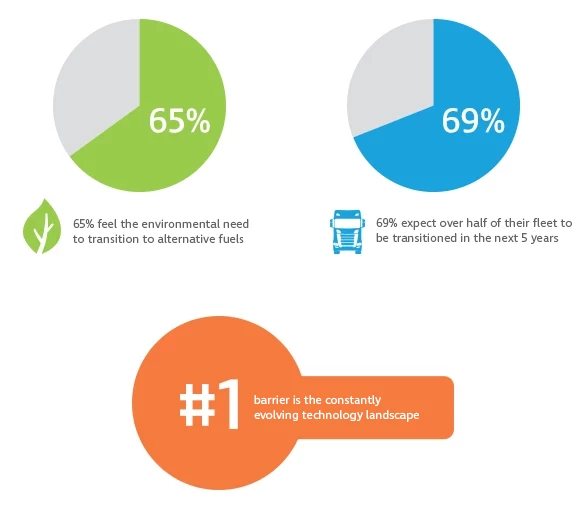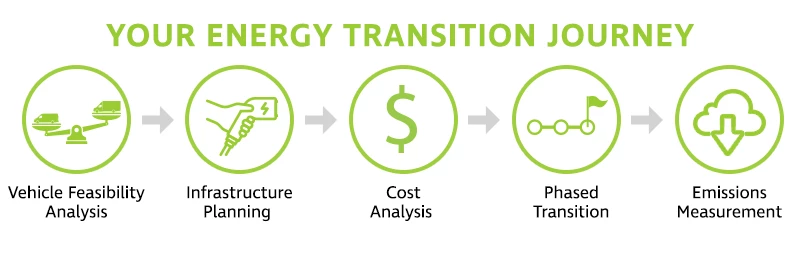By: Barney Goffer (Product Manager)
Key Takeaways
The push for fleets to transition to alternative fuels has never been more pronounced. Recent data, including insights from our TS24 Telematics Survey, paints a picture of fleet industries amid revolutionary change. Many operators find themselves in a unique situation as they develop plans to reduce environmental impact while learning about the rapidly changing technology landscape.
The only certainty is that operators need to pivot towards alternative fuels, embracing new technology and thinking innovatively to develop a more sustainable future.
Table of Contents
- Shift Toward Alternative Fuels
- Five Tips for Strategically Planning a Fleet Transition
- Get the Help You Need to Start Your Transition
The Shift Towards Alternative Fuels
Currently, 65% of fleet operators feel the environmental need to shift toward greener alternatives, but most acknowledge constant technological evolution as the principal hurdle. Surprisingly, a vast majority—69%—anticipate that over half of their fleet will transition to alternative fuels within the next five years, and a significant number of fleet managers note that their businesses are already in planning or early implementation stages.

Alternative Energy Adoption Trends
The variety of fleets undergoing alternative energy transitions is as diverse as the vehicles that compose them. From light commercial vehicles often spearheaded by local governments and municipal services to heavy goods vehicles now entering a phase of experimentation and trial with alternative energy solutions, transitioning is far from a uniform process across industries. However, fleets of all kinds are feeling the pressure to innovate.
Each fleet type, including those running on compressed natural gas (CNG) or with battery electric vehicles, faces its unique set of considerations, challenges, and timelines for transition. However, the numbers reveal a significant upward trend driven by technological advancements and an expanding policy framework to curb carbon emissions.
Driving Forces for Transition
Government mandates play a non-negotiable role in steering the direction of fleet transitions, dictating a shift from traditional internal combustion engines to more sustainable options. The adoption landscape is full of varying regional dynamics, with areas like Europe and parts of Asia moving at an accelerated pace compared to other regions, primarily influenced by robust governmental incentives and a noticeable shift in consumer sentiments.
Beyond the powers of regulation, there lies a powerful motivator in the form of operational cost savings and environmental stewardship. The ecological argument needs little introduction, with the transportation sector significantly contributing to global greenhouse gas emissions. Economically, the long-term cost savings from reduced fuel consumption and maintenance expenses present a persuasive argument. These factors underscore the transition as both a policy compliance exercise and a strategic business decision aimed at long-term sustainability and cost efficiency.
Target Sectors for Early Adoption
Certain sectors are well-positioned to lead fleet industries into alternative energy adoption. For instance, last-mile delivery services and municipal fleets can capitalize on their operational structures—characterized by predictable routes and shorter distances—to seamlessly integrate EVs into their operations. This transition enhances operational efficiency and notably reduces the carbon footprint associated with daily routes.
Additionally, the public-facing nature of these sectors offers a valuable opportunity to demonstrate a commitment to sustainability, influencing customer preferences and driving market differentiation. These sectors' visibility also bolsters a company's public image, aligning it with growing consumer expectations for sustainable practices and contributing to a broader societal shift towards environmental responsibility.
Episode 1: Exploring Mixed Energy Solutions Watch Full Episode Here.
Five Tips for Strategically Planning a Fleet Transition
As the transportation sector stands at the crossroads of innovation and sustainability, planning a fleet transition to alternative energy is both a strategic and environmental imperative. Here are five essential tips to guide you through this process.
Embrace Government Incentives and Understand Mandates
Government policies are pivotal in shaping fleet transitions. Emissions targets and financial incentives are key drivers in this shift. To navigate this successfully, begin with small, manageable changes, use the data available, and seek inspiration from the pioneers who have already made significant strides in this space.
Consider the Environmental Impact of Different Fuel Types
The transition narrative extends beyond just cutting carbon emissions. Various alternative fuels bring their own set of benefits and challenges. Electric vehicles (EVs) offer zero tailpipe emissions and are becoming increasingly viable with a more sustainable electricity grid. Additionally, hydrogen fuel cells present a promising solution for heavy-duty transport, though they necessitate careful consideration of energy efficiency and infrastructure development.
Reduce Your Carbon Emissions with Multi-Energy Fleet Solutions
See how Multi-Energy Fleet Solutions can help you start reducing carbon emissions.
Stay Informed About Technological and Infrastructure Advances
The future of fleet technology is on the brink of significant change. From advancements in battery technology that promise extended ranges and reduced charging times to the development of hydrogen fueling stations, these innovations will shape the practicality and feasibility of your fleet's transition. Keeping abreast of these developments will enable you to make informed decisions and plan effectively for their integration.
Leverage Real-World Examples and Data-Driven Insights
Both environmental benefits and the potential for profitability should drive the rationale for initiating your fleet's transition today.
Adopt a Proactive Stance and Start Small
Transitioning to alternative energy is a process that benefits from a thoughtful, step-by-step approach. Begin by identifying areas within your fleet most suited for an initial switch, leveraging the rich data available through telematics and other resources. This gradual, informed approach helps align environmental and regulatory goals while also laying the groundwork for a sustainable, economically viable fleet operation in the long term.

Get the Help You Need to Start Your Transition
Moving beyond carbon brings many benefits that extend far beyond emissions reductions. These benefits touch on every aspect of fleet operation, from cost savings to operational efficiency and market competitiveness.
To that end, the question isn't whether to start the transition but how quickly and effectively one can navigate this inevitable shift. With the right approach, informed by data, driven by policy, and motivated by sustainability, the transition to alternative energy offers a pathway to a greener, more efficient future. Now is the time to embrace this change, leveraging the lessons learned and the technologies available to steer your fleet into a new era of transportation.
For more information on alternative energy and how to transition your fleet, check out our library of alternative energy resources. You can also contact us for more information on how to best equip your fleet for the future.

